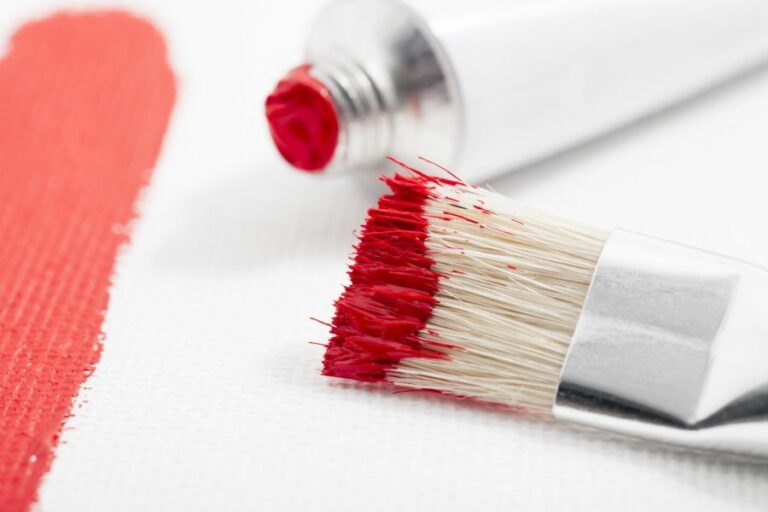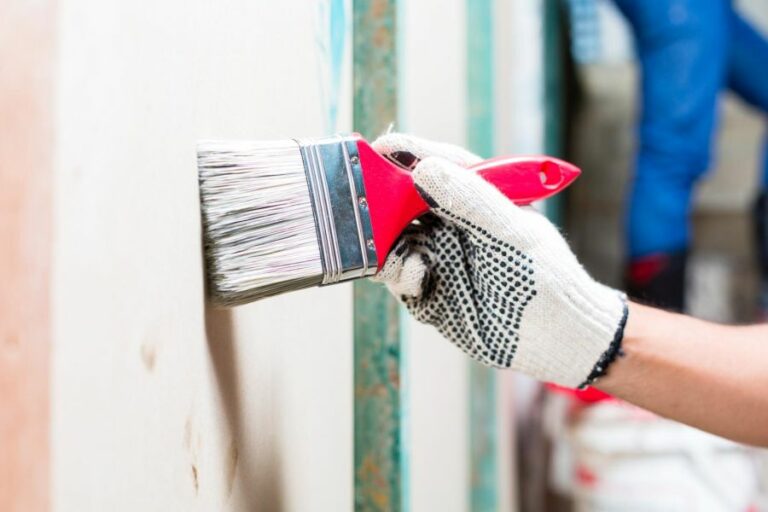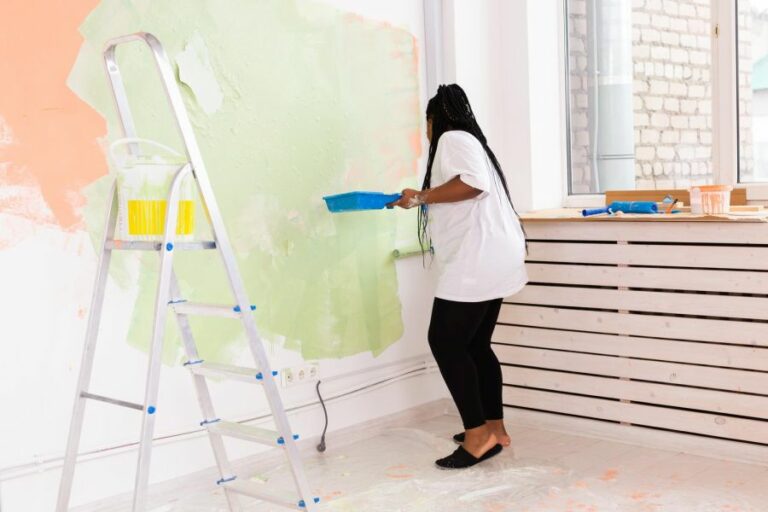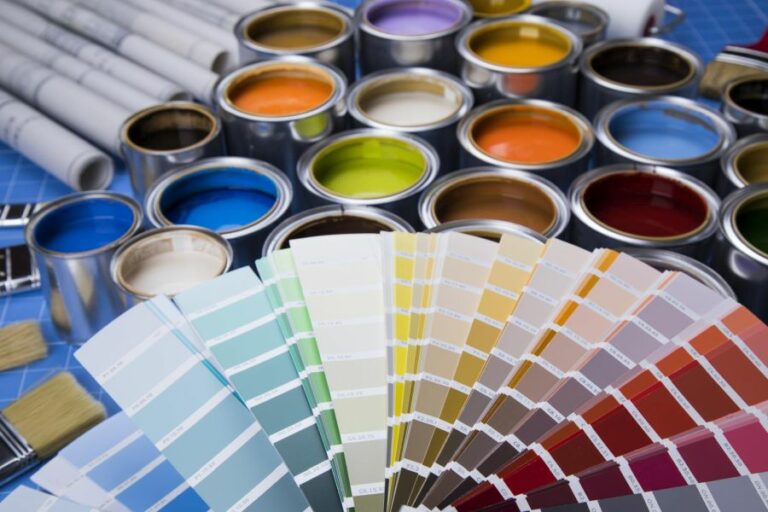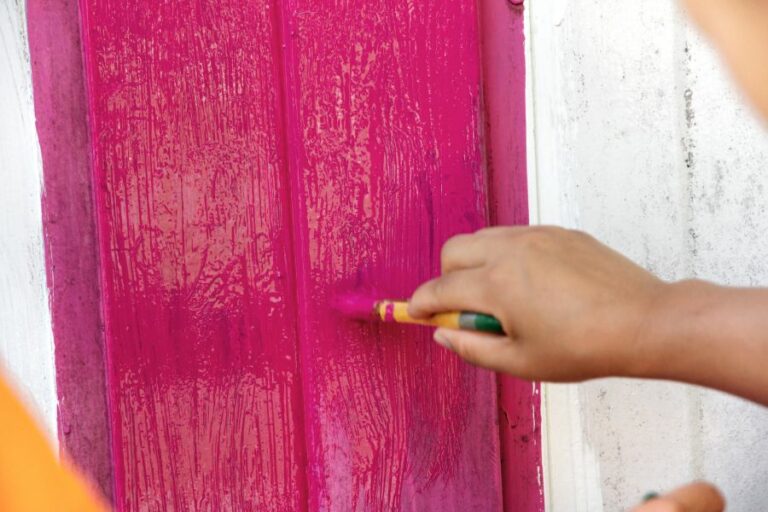Green Outdoor Paint, 25 Things You Should Know
Welcome to the refreshing blog post on green outdoor paint, a popular choice that injects life and blends seamlessly with nature. No wonder it’s taking the home design world by storm! In this post, you’ll discover the latest trends, expert tips for choosing the perfect shade, and creative ideas for incorporating green hues into your outdoor spaces.
Green outdoor paint:
Green outdoor paint enhances a home’s exterior appearance, offering eco-friendly options like acrylic latex, vinyl acetate, and linseed oil. Choosing the right shade of green and ensuring harmony with existing surfaces and neighborhood aesthetics is crucial. Proper surface preparation, application techniques, and maintenance enhance paint finish and durability. Investing in high-quality brushes and rollers, applying multiple coats, and painting in ideal weather conditions provide a professional finish, while regular cleaning and maintenance keep the exterior looking fresh.

Discover the eco-friendly world of green outdoor paint and elevate your home exterior’s aesthetics. Learn about various tones, finishes, and brands that provide durability and protection while preserving the environment. Make a long-lasting statement with sustainable choices.
Contents
- 1 Eco-Friendly Exterior Paint
- 2 Is green an appropriate choice for the exterior paint color?
- 2.1 • The Science Behind Green: Psychological Effects on People
- 2.2 • Various Shades of Green: An Overview
- 2.3 • Green Compatibility: Working with the Surrounding Environment and Architectural Style
- 2.4 • The Durability and Maintenance of Green Exterior Paint
- 2.5 • In Conclusion: Green Is a Solid Choice for Homeowners
- 3 Which Type of Paint is Most Suitable for Exterior Use?
- 4 Which Shade of Green is Most Suitable for a Porch?
- 5 Does the color of green exterior paint fade over time?
- 6 Identifying the Optimal Shade of Green for Paint Selection
Eco-Friendly Exterior Paint
Outdoor paint is an essential element when it comes to enhancing the appearance of your home’s exterior. Green outdoor paint, in particular, can add a touch of freshness and nature to your property.
• Different Types of Green Outdoor Paint
– Water-Based Paints
Water-based paints are generally more user-friendly, as they have a quicker drying time and produce fewer odors. These paints are also known for being environmentally friendly and easy to clean.
Acrylic Latex Paint
Acrylic latex is a widely popular green outdoor paint option. Its quick-drying properties and resistance to elements such as ultraviolet radiation and humidity make it an ideal choice for exterior applications.
Vinyl Acetate
While not as widely used as acrylic latex, vinyl acetate is another water-based outdoor paint option. Vinyl acetate is an excellent choice for surfaces that require more flexibility, such as wood and siding.
– Oil-Based Paints
Oil-based paints are generally more durable and provide an excellent finish. However, these paints have a longer drying time, emit a stronger odor, and can be challenging to clean up.
Alkyd Paint
Alkyd paints are well-known for their durability and long-lasting finish. They are an excellent option for outdoor use, particularly when it comes to woodwork and metal surfaces.
Linseed Oil Paint
Linseed oil paint is a natural paint made from linseed oil and pigment. It is known for its excellent penetration and ability to protect wood surfaces. Linseed oil paint is an eco-friendly alternative for those looking for green outdoor paint options.
• Choosing the Right Shade of Green
The shade of green you select will significantly impact the overall appearance of your property. Consider the following factors when choosing the right shade:
– Light vs. Dark Green
Light green shades can make your home look more spacious and provide an inviting atmosphere. On the other hand, dark green shades can create a more dramatic appearance, drawing attention to specific areas of your property.
– Harmony with Existing Surfaces
When selecting the color, ensure that it complements other materials and colors present in your home’s exterior, such as brick, wood, and stone.
– Neighborhood Aesthetic
Consider the colors used in your neighborhood and choose a shade that will visually harmonize with the surrounding homes.
• Preparing the Surface for Painting
It is crucial to properly prepare the surface before applying green outdoor paint to ensure a flawless finish and long-lasting durability. Follow these steps:
- Clean the surface of any dirt, dust, or debris.
- Scrape off any loose, flaking, or peeling paint.
- Fill in any cracks or holes using a suitable filler or caulk.
- Sand the surface to create a smooth, even texture.
- Apply a primer, especially when transitioning from a dark to a light shade or dealing with a porous or stained surface.
• Proper Application Techniques
Adhering to proper application techniques will ensure an even, professional finish. Here are some recommendations:
– Use High-Quality Brushes and Rollers
Invest in a high-quality brush or roller, as these tools will provide smoother application and reduce the likelihood of stray bristles left in the paint.
– Apply Multiple Coats
Applying multiple coats will ensure proper coverage and an even finish. Allow each coat to dry completely before applying the next one.
– Paint in Ideal Weather Conditions
Outdoor paint should be applied in dry, mild weather to ensure proper adhesion and help prevent premature cracking and peeling. Avoid painting in high temperatures or during high humidity.
• Maintenance Tips for Your Green Outdoor Paint
To keep your green outdoor paint looking fresh and lasting as long as possible, follow these simple maintenance tips:
- Clean dirt and debris from the painted surface regularly using a gentle soap and water mixture.
- Inspect for any signs of peeling, cracking, or fading, and address those areas promptly with touch-ups or repainting.
- Properly maintain the surrounding landscape, as overgrown plants and trees can cause moisture buildup or physical damage to the paint.
In conclusion, green outdoor paint can transform the appearance and appeal of your home. By thoroughly understanding different types of paint, selecting the right shade, and applying proper techniques, you can achieve a beautiful, durable, and long-lasting exterior.
Remember to keep up with regular maintenance to protect your investment for years.
Is green an appropriate choice for the exterior paint color?
• The Science Behind Green: Psychological Effects on People
Green, a color reminiscent of nature, tranquility, and growth, has often garnered the interest of homeowners considering exterior paint selections. The popularity of green as a paint color can be traced back to its psychological associations.
According to color psychology, green can evoke feelings of harmony, balance, and peace, making it a perfect choice for residential structures.
• Various Shades of Green: An Overview
Before choosing green exterior paint, it is essential to understand the different shades available and how they will impact the overall appearance of the exterior. Here are some well-known green shades that can complement a wide range of architectural styles:
– Sage Green
Sage green is a muted, grayish-green hue that is versatile and sophisticated. This shade can provide a timeless look, working well with traditional and contemporary designs alike. Often used for historic homes, sage green can give a refreshing touch while still maintaining the classic charm.
– Olive Green
Olive green is a rich, warm color that adds depth to the exterior of a home. The earthy undertones work well with natural materials like brick and wood, creating a cohesive look that harmonizes with the surrounding environment.
This shade is ideal for those who want to incorporate green while keeping a sense of sophistication.
– Mint Green
Mint green is a cheerful, bright shade that can add a touch of playfulness to the exterior. It is suitable for coastal and cottage-style homes, offering a fresh and vibrant look. Mint green is also an excellent choice for smaller homes, as the light hue can create an illusion of a larger space.
– Forest Green
Forest green is a deep, intense shade that brings to mind the lushness of dense woods. This bold choice can add character and depth to a home’s exterior while blending seamlessly with the landscape. Ideal for larger homes or those with generous gardens, forest green can create a majestic and stately appearance.
• Green Compatibility: Working with the Surrounding Environment and Architectural Style
Having a clear understanding of how the selected shade of green will complement the environment and architecture is crucial for achieving the desired aesthetics. The following factors should be taken into consideration:
– Environmental Considerations
The natural surroundings of the home play a significant role in determining the appropriate shade of green. Light greens, like mint green, are better suited for properties near the sea or in arid climates, while dark greens, such as forest green, are ideal for wooded or lush landscapes.
– Architectural Style
The architectural style of a home can also influence the choice of exterior green paint. For instance, modern and minimalist designs may require a more muted color, like sage green, whereas a traditional or historical home may look best in a more saturated hue, like olive green.
– Neighborhood Harmony
Lastly, it is essential also to consider the neighborhood’s color scheme when selecting an exterior paint color. While individuality is encouraged, harmonizing with the surrounding homes will maintain a cohesive look and contribute positively to the overall curb appeal.
• The Durability and Maintenance of Green Exterior Paint
One of the essential factors to consider when choosing exterior paint is the durability and required maintenance. Both of these aspects will impact the longevity and overall value of the paint job.
Luckily, green exterior paint, particularly in darker or more muted shades, is generally known for its durability. These shades can conceal dirt, mildew, and other imperfections more effectively than lighter colors.
Additionally, modern paint formulations have improved the fading resistance of green pigments, making them a low-maintenance choice for homeowners.
It is vital, however, to select high-quality paint products, as these are typically more resistant to common issues experienced with exterior paint, such as cracking, peeling, and fading.
• In Conclusion: Green Is a Solid Choice for Homeowners
In summary, green exterior paint is an excellent choice for homeowners due to its aesthetic appeal, versatility, and durability. The wide range of shades available allows for a tailored look that complements various architectural styles and environments.
The psychological association of green with balance, harmony, and growth further adds to the attractiveness of this color for residential properties.
By carefully selecting the appropriate shade and paint quality, homeowners can enjoy a beautiful, resilient, and low-maintenance paint job that enhances their home’s curb appeal and value.
Ultimately, as an experienced professional, I recommend exploring the vast array of green shades available to find the perfect match for your home’s unique characteristics and surroundings. The transformative power of a well-selected green exterior paint cannot be underestimated.
Which Type of Paint is Most Suitable for Exterior Use?
Painting the exterior of your home is a significant investment in time and money, so it’s essential to choose the right paint that will not only provide durability and protection but also enhance the overall appearance of your property.
• Types of Exterior Paints
There are mainly three types of paints used for exterior surfaces: latex, oil-based, and elastomeric. Each type has its specific attributes and performs differently on different surfaces.
– Latex Paint
This water-based paint is the most popular choice for exterior painting applications. It is known for its ease of application, quick-drying properties, and excellent color retention. Additionally, latex paint resists cracking and peeling, making it a more durable option.
Pros:
- Easy to clean with soap and water
- Low VOCs (Volatile Organic Compounds), making it more eco-friendly
- Resists mildew growth due to its natural elasticity
- Excellent adhesion to various surfaces, including wood, masonry, and metal
Cons:
- Not as durable as oil-based paint on specific surfaces like metal
– Oil-based Paint
Oil-based paints are revered for their durability, making them an ideal choice for high-traffic surfaces like doors, windows, and trim work. They provide a hard, protective finish that doesn’t wear or peel easily.
Pros:
- Exceptional durability
- Excellent adherence to various surfaces
- Resistant to peeling and flaking
Cons:
- High VOCs, making it less eco-friendly
- Longer drying time compared to latex paint
- Difficult to clean up (requires paint thinner or mineral spirits)
- Prone to mildew growth due to lack of flexibility
– Elastomeric Paint
Elastomeric paint is a high-performance option designed to provide exceptional durability and weatherization. It’s a thicker formula that creates a protective, flexible coating on the surface.
Pros:
- Resistant to cracking and peeling
- Excellent waterproofing properties
- Great for sealing hairline cracks and small surface imperfections
- Adheres well to various surfaces like stucco and masonry
Cons:
- Significantly thicker than other paints and may require specialized application techniques
- Costlier than latex and oil-based paints
• Factors to Consider When Choosing Exterior Paint
Before deciding on the type of paint to use for your home, consider the following key factors:
– Surface Material
The material of your home’s exterior plays a crucial role in determining the right paint choice. For instance, latex paint is ideal for most surfaces, including wood, masonry, and metal. Oil-based paint is recommended for metal surfaces and trim, while elastomeric paint is best suited for stucco and masonry.
– Climate
Different paints perform differently under various weather conditions. If you live in an area with high humidity, latex paint is an excellent option due to its resistance to mildew growth. Likewise, elastomeric paint is ideal for regions with extreme temperature fluctuations since it can expand and contract without cracking.
– Environmental Concerns
If you want an eco-friendly paint option with low VOCs, latex paint is the clear winner. However, if durability and longevity are your primary concerns, oil-based paint may still be the preferred choice.
– Aesthetic Preferences
The exterior paint’s color and finish also play a significant role in enhancing your home’s curb appeal. Latex paint is known for its excellent color retention, while oil-based paint provides a more robust, glossy finish.
• Expert Recommendations
Based on my experience, I recommend latex paint as the go-to option for most homeowners due to its ease of application, quick drying time, low VOCs, and excellent durability. It is also easy to clean and maintain, making it a popular choice for various surfaces.
For homeowners who prioritize durability or have specific surfaces like metal or high-traffic areas, oil-based paint would be a suitable choice due to its proven longevity and adherence.
Lastly, elastomeric paint is an ideal option for homes with stucco or masonry that require superior weather protection and waterproofing capabilities.
• Final Thoughts
Choosing the right exterior paint is crucial in ensuring your home is protected from the elements and maintains its aesthetic appeal.
By considering the surface material, climate, environmental concerns, and your personal preferences, you can select the best paint for your home’s unique needs.
And with proper preparation and application, your fresh coat of paint will not only enhance your home’s curb appeal but also ensure lasting protection for years to come.
Which Shade of Green is Most Suitable for a Porch?
• The Role of Color in Outdoor Spaces
Before delving into the specific tones of green that would excel in a porch setting, it is important to understand the significance of color in outdoor spaces.
The color scheme you choose for your porch contributes greatly to the overall aesthetic and atmosphere of your home’s exterior and interior. Additionally, the choice of color can impact the perception of space and comfort and influence your mood and well-being.
• Finding the Ideal Green for Your Porch
The color green is considered a versatile and natural choice for outdoor spaces, given its association with nature, growth, and relaxation. There are numerous shades of green that can suit various porch styles, design elements, and personal preferences.
– Classic Sage Green
Sage green is a timeless, muted shade that lends a feeling of tranquility and elegance to your porch. This soothing hue is a go-to choice for many homeowners, given its versatility in blending with various architectural styles and landscape designs.
As a pastel color, sage green also functions as a neutral foundation, allowing you to pair it with both warm and cool accent colors. Whether you opt for bold, contrasting colors or softer tones, sage green provides an elegant backdrop for your porch furniture and decor.
I highly recommend sage green for a sophisticated porch design that prioritizes comfort and serenity.
– Earthy Olive Green
For those looking to make a statement with their porch color scheme, olive green is an excellent choice. This deep, earthy shade adds warmth to your outdoor space while still maintaining a natural and organic feel.
Olive green also pairs well with a wide range of textures and materials commonly found in porch design, such as brick, stone, and natural wood. If you strive to create harmony between the natural and built environments, consider choosing olive green for your porch.
Personally, based on my experience, olive green works beautifully as an accent color, providing depth and contrast to your porch design without overpowering the space.
– Cheerful Mint Green
If your goal is to create a lively and energetic porch space, mint green is a vibrant choice that can add a pop of color to your exterior. This bright and refreshing hue resembles the color of fresh mint leaves, evoking feelings of rejuvenation and growth.
Mint green pairs exceptionally well with white and other light-colored trim or accents, making it a fitting choice for those who seek a crisp, clean look for their porch. This color also complements a variety of design styles, including modern, coastal, and traditional.
Having witnessed the transformative effect of mint green on many porches, I can confidently recommend this lively shade to those seeking a youthful and cheerful atmosphere.
– Relaxing Forest Green
The rich and luxurious hue of forest green lends an air of sophistication and depth to your porch. This deep shade creates a calming ambiance reminiscent of lush forests and serene wooded landscapes.
Forest green is particularly appealing for those with wooded surroundings, as it can help to emphasize the natural beauty of the environment while maintaining a sense of seclusion and privacy. Additionally, this hue pairs nicely with natural materials like wood and stone and with darker-toned metal accents.
I find that forest green is especially well-suited to porches with abundant greenery or those surrounded by various shades of nature. You cannot go wrong with forest green for a porch that exudes tranquility and refinement.
• Testing Your Green Selection
Once you have narrowed your choices to one or two shades of green, testing small swatches on your porch is crucial.
The appearance of colors can change dramatically depending on factors such as lighting, texture, and surrounding elements, making it essential to view your options in the actual location they will be applied in.
Testing your desired shade of green on your porch can avoid potential mismatching or dissatisfaction with the final result.
• Conclusion
Selecting the perfect shade of green for your porch requires consideration of your personal preferences, design aesthetics, and outdoor environment. Sage green offers timeless elegance, while olive green creates warmth and harmony between the built and natural spaces.
Mint green adds a lively and energetic touch, whereas forest green exudes sophistication and depth. By carefully evaluating your options and testing your chosen hue on your porch, you can find the ideal green that will transform your outdoor space into an inviting, stylish retreat.
Color Name | Color Code | Description |
|---|---|---|
Sage Green | #9EA87E | A muted green with a touch of gray, creating a calming feel |
Moss Green | #8A9A5B | A natural, earthy green reminiscent of mossy landscapes |
Eucalyptus Green | #7E8A5F | An organic green with undertones of blue that complements wood elements |
Forest Green | #228B22 | A rich, deep green that brings vibrancy and freshness to your porch |
Olive Green | #708238 | A warm, earthy green that adds depth and character to your porch space |
Does the color of green exterior paint fade over time?
The exterior paint of a building is its first line of defense against harsh weather conditions and other factors that can impact its overall look and functionality. Green exterior paint, in particular, has grown increasingly popular for its aesthetic appeal and eco-friendly connotations.
However, one question that comes to mind is whether or not green exterior paint is prone to fading.
• The Impact of Sunlight on Exterior Paint
– Ultraviolet Rays and Paint Fading
One of the primary causes of paint fading is sunlight, more specifically, ultraviolet (UV) radiation. UV rays break down the chemical bonds in paint, losing color intensity and causing the paint to become chalky or powdery in consistency.
This process, known as photodegradation, affects all types of paint colors, including green.
Green exterior paint may fade to varying degrees, depending on the specific shade of green and the type of paint used. Lighter shades may show signs of fading earlier than darker shades, while certain paint formulations may be more resistant to the effects of UV radiation.
– Reducing Sun-Related Fading with Protective Measures
Proper precautions can be taken to minimize the effects of sun-related fading on green exterior paint. This can include the use of high-quality exterior paint with built-in UV protection or an additional protective topcoat.
Regular maintenance, such as cleaning and retouching the paint, can also help maintain the vibrancy of the color and keep the paint in good condition.
• Variables that Affect Paint Fading
While sunlight is a major contributor to paint fading, other factors must be considered when determining if green exterior paint is likely to fade.
– The Quality of the Paint
The quality of the paint can significantly impact how prone it is to fading. High-quality paints, while often more expensive, are formulated with better pigments, binders, and additives that can resist fading and maintain their vibrancy for longer periods.
– Pigment Type and Concentration
The type of pigment used in green exterior paint and its concentration can also impact how prone it is to fading. In general, inorganic pigments tend to be more resistant to fading than organic ones.
Additionally, higher pigment concentrations can provide increased protection against fading and ensure longer-lasting color.
– Paint Formulation and Additives
Some paint formulations, such as those containing UV-inhibiting additives, are specifically designed to resist fading. These additives can help protect the paint from the harmful effects of ultraviolet radiation and maintain the vibrancy of green exterior paint for longer.
• Maintenance Matters: How to Prevent Green Exterior Paint from Fading
Regular maintenance is essential to keep green exterior paint looking fresh and vibrant over time. The following tips can help prevent paint from fading and extend the paint job’s life.
– Regular Cleaning
Dirt and grime can make the paint appear dull and faded and, when left to accumulate, can further exacerbate the issue. Regular cleaning with a soft brush and mild soapy water can help prevent the build-up of dirt and maintain the paint’s vibrancy.
– Periodic Touch-Ups
Fading may be more noticeable in certain areas of a building, particularly those exposed to direct sunlight for extended periods. Periodically touch up these areas with fresh paint to counteract the effects of fading and maintain a uniform appearance.
– Consider a Topcoat
Applying a clear protective topcoat after painting can help shield the paint from the elements and UV radiation, thus reducing fading. This topcoat can be applied immediately following the application of the green exterior paint or added once signs of fading begin to appear.
In conclusion, while green exterior paint can fade over time due to factors such as sunlight, pigment type, and paint quality, proper maintenance and preventative measures can help counteract this issue and keep the paint looking fresh and vibrant for years to come.
Building owners can reap the benefits of beautiful, long-lasting green exterior paint by investing in high-quality paint, utilizing protective additives and topcoats, and conducting regular maintenance.
Identifying the Optimal Shade of Green for Paint Selection
• Understanding the Different Shades of Green
When it comes to green color paint, a wide variety of shades are available. Ranging from soft, muted tones to vibrant and bold hues, each shade of green carries its unique character and charm.
Before diving into the best green color paint options, it is useful to become familiar with various types of green color subcategories:
– Cool Greens
Cool greens have a touch of blue in them, making them feel fresh and soothing. They can create a calm and tranquil atmosphere, perfect for bedrooms, bathrooms, or any space where relaxation is essential.
– Warm Greens
Warm greens have a hint of yellow, giving them a more energetic and inviting feel. They can create a comfortable and friendly ambiance, making them suitable for living spaces such as the living room or kitchen.
– Earthy Greens
Earthy greens have a neutral base, with tones leaning towards brown or gray. They are reminiscent of nature’s earthy elements, making them ideal for creating a serene, grounded environment. These shades might be fitting for den, study, or entryway.
• The Best Green Color Paints for Interior Spaces
– Soft Green: Benjamin Moore’s Silver Crest (1583)
A classic, muted green with a soothing touch, Benjamin Moore’s Silver Crest has a timeless appeal, perfect for bedrooms, bathrooms, or any space where relaxation is crucial. Its soft hue makes it versatile, allowing it to complement various design styles, from traditional to modern.
– Energetic Green: Sherwin-Williams’ Overt Green (SW 6786)
Energetic and vibrant, Sherwin-Williams’ Overt Green is a bold choice for a contemporary living space. This shade brings life and energy to any room, creating an inviting atmosphere that will encourage conversation and engagement.
I recommend this color for a living room, dining room, or any area where social interaction takes place.
– Earthy Green: Farrow & Ball’s Pigeon (No. 25)
Farrow & Ball’s Pigeon is a classic and peaceful earthy green that exudes contentment and security. Its neutral base makes it adaptable to a variety of interiors, while its resemblance to natural elements can encourage a grounded mood in the space.
This color can work incredibly well in entryways or home offices where a balance of inspiration and serenity is essential.
• The Best Green Color Paints for Exterior Spaces
– Exterior Green: Behr’s Back to Nature (S340-4)
Behr’s Back to Nature is a warm, earthy-green paint that can create a harmonious and natural look on the exterior of your home. It pairs well with wooden elements and other earth-toned colors, making it ideal for traditional or rustic-styled exteriors.
– Door Green: Benjamin Moore’s Essex Green (HC-188)
A rich, deep, and sophisticated green, Benjamin Moore’s Essex Green is perfect for creating a striking and welcoming entrance when painted on a front door. Its boldness contrasts well with neutrals to create an eye-catching statement, making your home stand out from the rest.
• Tips for Choosing the Best Green Color Paint for Your Space
1. Consider the Lighting
The way a particular green paint looks on your walls may depend on the lighting conditions in the space. It’s always wise to test paint samples on the walls in various areas of the room to see how it responds to natural and artificial light.
2. Coordinate with Your Design Style
Each shade of green can work best with a specific design style. Be sure to consider your space’s overall look and feel, and choose a green paint that aligns with your existing decor.
3. Factor in the Mood You Want to Create
The right shade of green can evoke a specific mood, whether calm, energetic, or grounded. As you begin exploring your options, think about the ambiance you aim to create in the space and how each green paint option might contribute to that desired effect.
In conclusion, the best green color paint for your needs depends on your home’s specific space, lighting, and overall aesthetic.
By understanding the distinctive qualities of various green shades and keeping your unique requirements in mind, you can create a truly harmonious and inviting atmosphere using the perfect green paint.
No matter your choice, there is a green color paint that can undoubtedly enhance the beauty and charm of your space.

